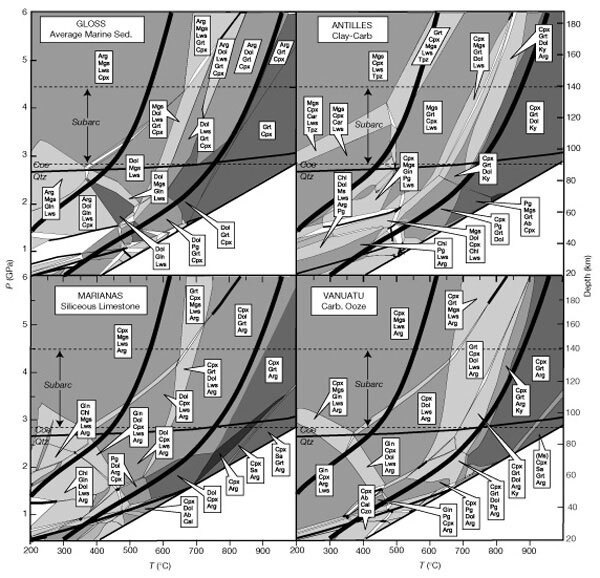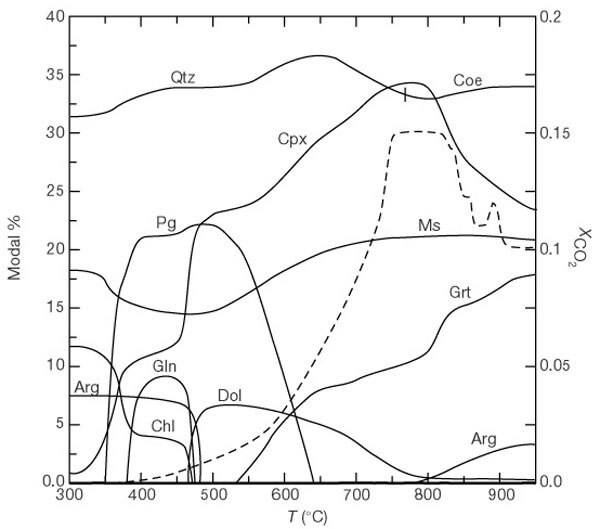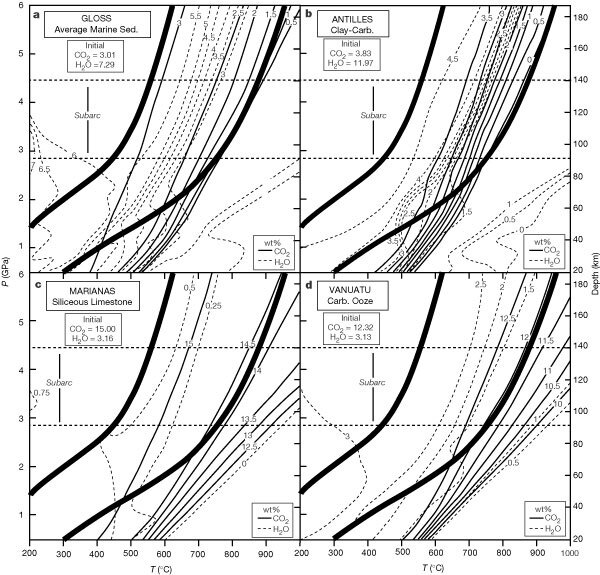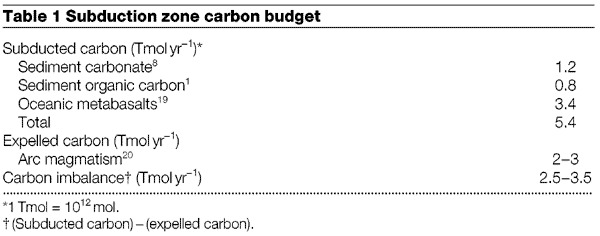Abstract
Volatiles, most notably CO2, are recycled back into the Earth's interior at subduction zones1,2. The amount of CO2 emitted from arc volcanism appears to be less than that subducted, which implies that a significant amount of CO2 either is released before reaching the depth at which arc magmas are generated or is subducted to deeper depths. Few high-pressure experimental studies3,4,5 have addressed this problem and therefore metamorphic decarbonation in subduction zones remains largely unquantified, despite its importance to arc magmatism, palaeoatmospheric CO2 concentrations and the global carbon cycle6. Here we present computed phase equilibria to quantify the evolution of CO2 and H2O through the subduction-zone metamorphism of carbonate-bearing marine sediments (which are considered to be a major source for CO2 released by arc volcanoes6). Our analysis indicates that siliceous limestones undergo negligible devolatilization under subduction-zone conditions. Along high-temperature geotherms clay-rich marls completely devolatilize before reaching the depths at which arc magmatism is generated, but along low-temperature geotherms, they undergo virtually no devolatilization. And from 80 to 180 km depth, little devolatilization occurs for all carbonate-bearing marine sediments. Infiltration of H2O-rich fluids therefore seems essential to promote subarc decarbonation of most marine sediments. In the absence of such infiltration, volatiles retained within marine sediments may explain the apparent discrepancy between subducted and volcanic volatile fluxes and represent a mechanism for return of carbon to the Earth's mantle.
Main
A premise of our work is that realistic modelling of metamorphic devolatilization of subducted lithologies is only possible on the basis of phase equilibria in chemical systems closely approximating actual bulk compositions. Our studies on metamorphic devolatilization of the other two main carbonate-bearing lithologies involved in subuction zones (ophicarbonates and metabasalts) are considered elsewhere2,7. Carbonate is abundant in two main pelagic marine sediment lithologies8: (1) siliceous limestones and (2) clay-carbonates (marls). From the database of ref. 8 (see Supplementary Information) we selected bulk compositions of siliceous limestones from the Marianas and Vanuatu trenches, a marl from the Antilles trench and their average marine sediment bulk composition (denoted ‘GLOSS’ in ref. 8). Our computations account for the oxide components: SiO2, Al2O3, FeO, MgO, CaO, Na2O, K2O, CO2 and H2O.
For each marine sediment bulk composition, the corresponding phase diagram section (Fig. 1) was computed as a function of pressure (P) and temperature (T) by free-energy minimization9. The thermodynamic database of ref. 10 was used for the properties of all end-member species, and mineral solutions were modelled as described elsewhere9. Thermodynamic data for H2O, CO2 and their mixtures were computed from the equation of state given in ref. 11. To track metamorphic devolatilization along the top of subducted slabs, we adopted the geotherms12 for the subduction zones of northwestern and southeastern Japan (Fig. 1). These geotherms are reasonable approximations for the respective extremal low-temperature and high-temperature geotherms for subduction zones (S. M. Peacock, personal communication).
Figure 1. Phase equilibria computed for selected bulk compositions from the database of ref. 8.

Further details are available in Supplementary Information. The computer programs, and the thermodynamic data and equations of state utilized by these programs, are available at http://www.erdw.ethz.ch/∼jamie/perplex.html. Mineral abbreviations are: Ab, albite; Arg, aragonite; Cal, calcite; Car, Mg-Fe carpholite; Chl, chlorite; Coe, coesite; Cpx, clinopyroxene; Czo, clinozoisite; Dol, dolomite; Gln, glaucophane; Grt, Garnet; Ky, kyanite; Lws, lawsonite; Mgs, magnesite; Pg, paragonite; Qtz, quartz; Sa, Sanidine; Tpz, topaz. With the exception of muscovite absence (denoted by (Ms)) in a high-temperature field of Vanuatu, muscovite + quartz/coesite + fluid is present in all phase fields. The shading denotes the variance of the phase fields. Univariant phase fields are denoted by thick lines. The semi-parallel thickest curves are geotherms for southeastern (right) and northwestern (left) Japan12. The subarc depth range is from ref. 18. Assemblages in the small phase fields below ∼1.5 GPa are omitted for clarity.
Because of compositional degrees of freedom in the crystalline and fluid phases, the phase diagram sections are dominated by multivariant phase fields. Consequently, both mineral modes and compositions vary continuously along geotherms (Fig. 2). Phase relations along geotherms up to a pressure P ≈ 3 GPa change significantly (Fig. 1) because of intersection with numerous phase field boundaries. However, at P > 3 GPa, the geotherms are subparallel to the phase field boundaries (Fig. 1); consequently, little reaction occurs along geotherms at P > 3 GPa. The differences between these regimes are illustrated in Fig. 2. Accordingly, significant changes in the mineralogy and mineral proportions occur up to ∼800 °C (P ≈ 3 GPa ) whereas there is comparatively little variation above ∼800 °C.
Figure 2. Modal percentages of minerals and fluid composition.

Modal percentages of minerals (left ordinate and solid lines) and fluid composition (right ordinate and dashed line) are shown for the average marine sediment bulk composition (‘GLOSS’ in ref. 8) along the high-temperature geotherm shown in Fig. 1. Phase abbreviations as in Fig. 1. The vertical line at ∼770 °C marks the quartz–coesite equilibrium.
The fluid composition (Fig. 2) is controlled by multivariant equilibria involving carbonates and hydrous phases. The rise in the mole fraction of CO2, , up to ∼750 °C correlates with consumption of carbonates (Fig. 2), whereas the diminution in above ∼750 °C occurs because of aragonite production. To track loss of volatiles we computed the percentage (by weight; wt%) of H2O and CO2 for carbonate-bearing marine sediments as a function of pressure and temperature (Fig. 3). In the lower-pressure half of Fig. 3, the negative P–T slopes of the wt% H2O isopleths reflect negative slopes of phase field boundaries (Fig. 1). In contrast to isopleths with negative slopes at lower pressures, isopleths are subparallel to geotherms at P > 2–3 GPa (Fig. 3).
Figure 3. Weight percentages of CO2 and H2O for selected marine sediment bulk rock compositions (see Fig. 1).

a, Gloss; b, Antilles; c Marianas; d, Vanuatu. Heavy curved lines are limiting geotherms (see Fig. 1). Values of the initial wt% CO2 and H2O are given in the insets (from ref. 8). The CO2 and H2O contents of the fluid phase can be determined by subtracting the data in these diagrams from the initial volatile contents of the protoliths.
Siliceous limestones release about 1 wt% CO2 and 1 wt% H2O along the high-temperature geotherm (Fig. 3c, d). Because less CO2 and H2O are released along lower-temperature geotherms, most of the volatile content of siliceous limestones is retained to depths of 180 km and thus such lithologies would undergo little devolatilization upon subduction. This conclusion is compatible with the existence of ultrahigh-pressure marbles13.
In contrast with siliceous limestones, H2O-rich lithologies with low initial carbonate contents (that is, clay-rich marls) are predicted to undergo considerably more devolatilization (Fig. 3b). Along the high-temperature geotherm, all of the initial CO2 (4 wt%) and most of the initial H2O (10–11 wt%) is released by 90 km depth (that is, forearcs). For geotherms in the lower-temperature half of the area bounded by the limiting geotherms (Fig. 3b), relatively little CO2 and H2O would be released. For various geotherms in the higher-temperature half of the area bounded by the limiting geotherms (Fig. 3b), there are significant differences in the amount of devolatilization.
For the carbonate-bearing protoliths considered here, the geotherms at 80–180 km are subparallel to the H2O and CO2 isopleths (Fig. 3); thus, little or no devolatilization is expected. Consequently, for closed-system behaviour, subducted carbonate-bearing marine sediments would not provide a source of volatiles for arc magmatism. However, decarbonation of marine sediments at these depths may be driven by infiltration of H2O-rich fluids originating from intercalated hydrous pelagic or terrigenous sediments, and/or metabasalts in the subjacent slab. Computed7 and experimentally determined14 high-pressure phase equilibria imply that significant proportions of the initial H2O in subducted oceanic metabasalts are released under forearcs and subarcs. Infiltration of the evolved fluid into the overlying subducted sediments would induce decarbonation. But because there are no major dehydration ‘pulses’ in subducted metabasalts under volcanic arcs7,14, no corresponding pervasive infiltration of water from dehydrating metabasalts is expected in subarcs. Barring extensive infiltration of externally derived fluids, our study implies marked devolatilization under forearcs (for clay-rich marls with high-temperature geotherms) or retention of H2O and CO2 to depths well beyond subarcs (for siliceous limestones in all geotherms and clay-rich marls with low-temperature geotherms). Accordingly, most of the initial CO2 and H2O in subducted marine sediments will not be released beneath volcanic arcs. This inference is consistent with both the deficiency in the amount of CO2 released from arc volcanoes compared to the amount of CO2 contained within subducted carbonates (Table 1) and with the imbalance between subducted versus expelled H2O (ref. 1).
Table 1.
Subduction zone carbon budget

Our equilibrium analysis implicitly assumes that there is no significant kinetic overstepping and metastability of metamorphic reactions. Although significant disequilibrium has been suggested for the transformation of anhydrous oceanic basalts and gabbros to eclogites15, the catalytic effect of H2O (ref. 15) implies that equilibrium is more likely in dehydrating systems such as subducted sediments.
Melting is an alternative mechanism for release of volatiles from subducted sediment. Recent experiments using marine red clay16 suggest that sediment melting does not occur for the geotherms that we consider here. However, because metastable starting materials (for example, red clay) are unsuitable models for subduction-zone metamorphism and melting, confirmation of this conclusion requires experiments with more realistic initial mineral assemblages. Dissolution of minerals in supercritical fluids remains a possible, albeit largely unquantified, alternative mechanism for devolatilization.
As shown in Fig. 2, fluids produced by metamorphism of subducted marine sediments are H2O-rich. Consequently, expulsion of such fluids to the overlying mantle wedge would not substantially affect the P–T conditions of melting (solidus) of the mantle wedge compared to those expected in the presence of a pure H2O fluid.
Devolatilization of subducted sediment could contribute to seismicity along the tops of subducted slabs. The continuous nature of devolatilization is compatible with the spread of earthquake hypocentres along individual subduction zones17. However, correlation of slab seismicity with metamorphic devolatilization of subducted sediments needs to consider the marked differences in devolatilization for different bulk compositions and geotherms.
Supplementary information
TABLE 2.
Bulk Oxide Compositions (wt. %) of Marine Sediments
| Oxide | GLOSS* | Antilles** | Marianas*** | Vanuatu**** |
|---|---|---|---|---|
| SiO2 | 58.57 | 46.57 | 56.53 | 44.76 |
| TiO2 | 0.62 | 0.70 | 0.233 | 0.365 |
| Al2O3 | 11.91 | 17.99 | 2.30 | 11.16 |
| FeO | 5.21 | 7.38 | 1.56 | 3.13 |
| MnO | 0.32 | 0.17 | 0.03 | 0.11 |
| MgO | 2.48 | 1.61 | 0.81 | 1.59 |
| CaO | 5.95 | 5.45 | 19.23 | 18.58 |
| Na2O | 2.43 | 1.91 | 0.47 | 3.58 |
| K2O | 2.04 | 2.83 | 0.60 | 0.95 |
| P2O5 | 0.19 | 0.08 | 0.084 | 0.126 |
| CO2 | 3.01 | 3.83 | 15.00 | 12.32 |
| H2O | 7.29 | 11.97 | 3.16 | 3.13 |
All bulk compositions are from Table 1 of Plank and Langmuir8.
* Average marine sediment bulk composition ("GLOSS") in Table 3 of Plank and Langmuir8.
** Designated "Ant Fe-cc clay" in Table 1 of Plank and Langmuir8.
*** Designated "Marianas Chert-Lst" in Table 1 of Plank and Langmuir8.
**** Designated "Van Nanno" in Table 1 of Plank and Langmuir8
Acknowledgements
We thank S. Peacock for advice about subduction zone geotherms, and G. Bebout, K. Caldeira and M. Schmidt for comments and suggestions. This work was supported by the MARGINS program of the NSF.
References
- 1.Bebout GE. The impact of subduction-zone metamorphism on mantle-ocean chemical cycling. Chem. Geol. 1995;126:191–218. doi: 10.1016/0009-2541(95)00118-5. [DOI] [Google Scholar]
- 2.Kerrick DM, Connolly JA. D. Subduction of ophicarbonates and recycling of CO2 and H2O. Geology. 1998;26:375–378. doi: 10.1130/0091-7613(1998)026<0375:SOOARO>2.3.CO;2. [DOI] [Google Scholar]
- 3.Yaxley GM, Green DH. Experimental demonstration of refractory carbonate-bearing eclogite and siliceous melt in the subduction regime. Earth Planet. Sci. Lett. 1994;128:313–325. doi: 10.1016/0012-821X(94)90153-8. [DOI] [Google Scholar]
- 4.Molina JF, Poli S. Carbonate stability and fluid composition in subducted oceanic crust: an experimental study on H2O-CO2 bearing basalts. Earth Planet. Sci. Lett. 2000;176:295–310. doi: 10.1016/S0012-821X(00)00021-2. [DOI] [Google Scholar]
- 5.Domanik KJ, Holloway JR. Experimental synthesis and phase relations of phengitic muscovite from 6.5 to 11 GPa in a calcareous metapelite from the Dabie Mountains, China. Lithos. 2000;52:51–77. doi: 10.1016/S0024-4937(99)00084-5. [DOI] [Google Scholar]
- 6.Caldeira K. Continental-pelagic carbonate partitioning and the global carbonate-silicate cycle. Geology. 1991;19:204–206. doi: 10.1130/0091-7613(1991)019<0204:CPCPAT>2.3.CO;2. [DOI] [PubMed] [Google Scholar]
- 7.Kerrick, D. M. & Connolly, J. A. D. Metamorphic devolatilization of subducted oceanic metabasalts: Implications for seismicity, arc magmatism and volatile recycling. Earth Planet. Sci. Lett. (in the press).
- 8.Plank T, Langmuir CH. The chemical composition of subducting sediment and its consequences for the crust and mantle. Chem. Geol. 1998;145:325–394. doi: 10.1016/S0009-2541(97)00150-2. [DOI] [Google Scholar]
- 9.Connolly JAD. Multivariable phase diagrams: an algorithm based on generalized thermodynamics. Am. J. Sci. 1990;290:666–718. doi: 10.2475/ajs.290.6.666. [DOI] [Google Scholar]
- 10.Holland T, Powell R. An internally consistent thermodynamic data set for phases of petrologic interest. J. Metamorph. Geol. 1998;16:309–343. doi: 10.1111/j.1525-1314.1998.00140.x. [DOI] [Google Scholar]
- 11.Holland T, Powell R. A compensated Redlich-Kwong (CORK) equation for volumes and fugacities of CO2 and H2O in the range 1 bar to 50 kbar and 100-1600°C. Contrib. Mineral. Petrol. 1991;109:265–273. doi: 10.1007/BF00306484. [DOI] [Google Scholar]
- 12.Peacock SM, Wang K. Seismic consequences of warm versus cool subduction metamorphism: Examples from Southwest and Northeast Japan. Science. 1999;286:937–939. doi: 10.1126/science.286.5441.937. [DOI] [PubMed] [Google Scholar]
- 13.Becker H, Altherr R. Evidence from ultra-high-pressure marbles for recycling of sediments into the mantle. Nature. 1992;358:745–748. doi: 10.1038/358745a0. [DOI] [Google Scholar]
- 14.Schmidt MW, Poli S. Experimentally based water budgets for dehydrating slabs and consequences for arc magma generation. Earth Planet. Sci. Lett. 1998;163:361–379. doi: 10.1016/S0012-821X(98)00142-3. [DOI] [Google Scholar]
- 15.Hacker BR. Subduction Top to Bottom. 1996. pp. 337–346. [Google Scholar]
- 16.Johnson MC, Plank T. Dehydration and melting experiments constrain the fate of subducted sediments. Geochem. Geophys. Geosyst. 1999;1:1525–2027. [Google Scholar]
- 17.Kirby S, Engdahl ER, Denlinger R. Subduction Top to Bottom. 1996. pp. 195–214. [Google Scholar]
- 18.Tatsumi Y, Eggins S. Subduction Zone Magmatism. 1995. [Google Scholar]
- 19.Alt JC, Teagle DAH. The uptake of CO2 during alteration of the ocean crust. Geochim. Cosmochim. Acta. 1999;63:1527–1535. doi: 10.1016/S0016-7037(99)00123-4. [DOI] [Google Scholar]
- 20.Marty B, Tostikhin IN. CO2 fluxes from mid-ocean ridges, arcs and plumes. Chem. Geol. 1998;145:233–248. doi: 10.1016/S0009-2541(97)00145-9. [DOI] [Google Scholar]


